Overview of the Chinese DPSS 532nm Laser
Recently, the Chinese have mastered the production of relatively powerful and inexpensive solid-state lasers with diode pumping ( DPSS ). Surely many would be interested to know what is inside them, what characteristics these lasers have and what the Chinese have saved on.

Under the cut - a review of such a necessary thing in every home as a single-watt green laser.
Before I write something, I want to emphasize in capital letters:
In this review there will be no video on how the laser sets fire to matches, pops balls, etc.: in bulk in Youtube. Instead, we will check the compliance of the declared characteristics with the real ones, and, of course, consider the design of this device - the required dose of geek porn is provided.
The laser was manufactured by CST (whose products are considered somewhat better than DHOM products) by order of UltraLasers, Inc. It belongs to the highest class IV laser hazard , i.e. In addition to protection (glasses), when working with it, it is necessary to use a radiation trap-absorber, and it is also necessary to fix the emitter motionless so that the affected wire does not rotate the head in an unknown direction.
Let's go through the characteristics in order.
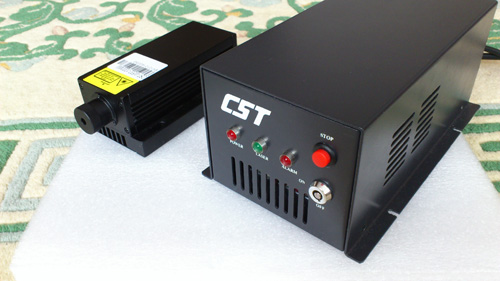
FAIL. Not only 532nm (green) shines from the aperture, but also 808nm and 1064nm (invisible infrared). And it shines so that this cannot be ignored. An infrared filter was not placed in the laser.
TRUE Full output power at all wavelengths exceeds 2.5W. The output of useful green - about 1.8W , which also significantly exceeds the declared power - is a characteristic feature of all Chinese lasers of this type.

From the measurements it follows that the invisible infrared part of the radiation accounts for about 700 milliwatts, which are much easier to get into the unprotected eye than it seems (see the next paragraph).
FAIL. The measured discrepancy for 532nm was 2.3 mrad. For 808nm - an order of magnitude larger, about 30 mrad. It looks like this: Violet is IR. Pay attention to the relative brightness of IR and green. The diameter of the green ray corresponds to a white spot in the photograph, the green border is already scattering from the surface. Thus, holding your head near the green beam (when adjusting the optics, etc.), there is a considerable chance of falling under the IR beam, which will freely pass through glasses that protect against 532nm, and will bring a lot of joy to ophthalmologists. Therefore, once again: Be sure to install an infrared filter!
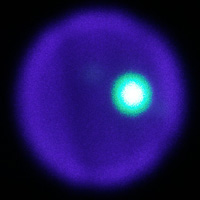
TRUE And there is.
FAIL. The lower order Gaussian-Lagerr mode is obtained only with completely insignificant power (less than 50 mW). Above this threshold, we have something like this: Already not TEM 10 , but also not TEM 11 . This is quite typical: with such a resonator and power it is difficult to avoid amplification of higher order modes.

FAIL. For testing, I collected a simple TTL PWM at 26 kHz on my knee (Warning, deadly number! Without microcontrollers and FPGAs!) From the available components (LM339 comparator plus harness):
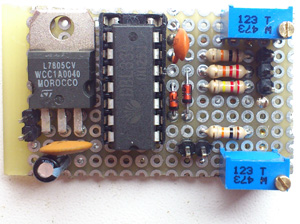
And with different duty cycle, I got these oscillograms on the photodiode:

25%
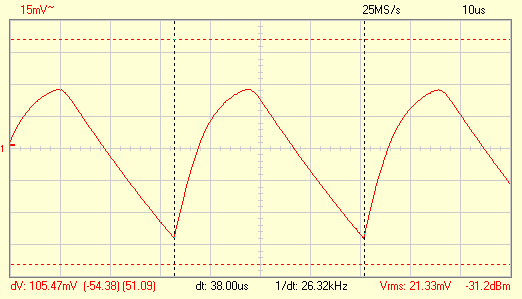
50 %

75%
Not much left of the input rectangular TTL. The spectrum of the signal, as expected, is replete with harmonics:
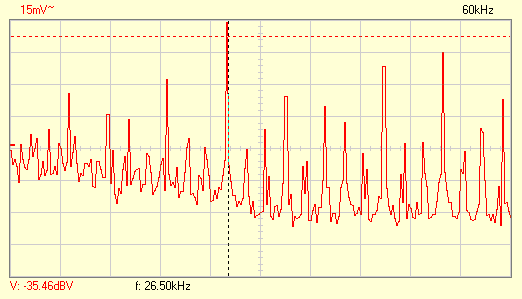
TRUE Both Peltier and fan are present. During operation, the emitter housing practically does not heat up.
When working with DPSS lasers, it is useful to have an infrared sight. The most affordable option is to buy a cheap digital soap dish and remove an infrared filter from it. As a result, instead of one useless thing, we get two useful ones: an IR camera and a filter. I take IR photographs with the Olympus VG-150, which cost me less than 2000 rubles, including delivery. In addition, the filter in it is not glued to the matrix, but simply lies on it, pressed down by an elastic band, and is removed without difficulty and damage in two minutes.
The same filter can also be used for a laser: its maximum transmission is just in the green region. Just do not recommend mounting it directly on the outlet (even from the inside) - the light scattered on the filter is enough to unpleasantly blind.
On BP are present:
Then the Chinese planted a pig : the laser turned on with the lock unlocked and the key turned off, just when you click the button back! This gross violation of TB at the first start-up is very, hmm, surprised. At the same time, I checked the Stop button.
Opening the unit showed that for user convenience, the key and lock connectors are closed with a “nozzle” on the back of the board, and the switch with the key is not connected at all:
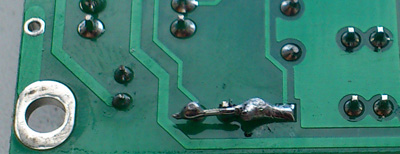
Structurally, the unit consists of two modules: a switching power supply for 5 and 12 volts and a combined diode driver with regulator for two thermocouples.
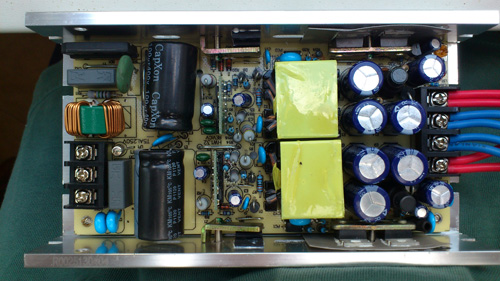
Represents two identical sources in one case: the first - 12V 6.5A, the second - adjustable 4.6–6.3V 6.5A. Do not be confused by the same colors of wires: the top red ones are 5V and the bottom red ones are 12V.
Not distinguished by its sophisticated design: Three linear current stabilizers on the LM358 op amp and output stages on the IRF530N (MOSFETs on the back of the board) - for the laser diode and two thermocouples. Only one thermocouple is used. The upper left microcircuit is 74LS00, it turns on the laser under the condition of a high level on the TTL modulation connector, the temperature of the sensors matches the expected temperature and the five-second delay timer generated on the NE555 microcircuit (lower left). All other chips are LM358. The leftmost resistor controls the laser current. Large resistors are used as current-measuring shunts. MOSFETs are bolted to a massive heatsink the size of the entire driver board. The laser current stabilizer is powered by + 5V, and thermocouples from + 12V.
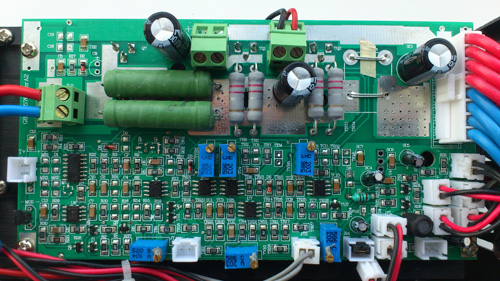
The quality of the soldering is average, with traces of manual refinement by a file. Saved on filter elements, otherwise there is no special crime.
The laser current is set to 5.4A, which suggests that the working fluid is pumped by a five-watt IR laser diode. The absence of a second thermocouple means that the KTP crystal does not heat up, and therefore, it may not work in optimal mode, which reduces its service life.
Perhaps the only thing that meets the specifications in this laser is power. But she was given with a margin. The expected service life is also doubtful, but this will become clear when disassembling the emitter. This review, and so it turned out quite voluminous, incl. I will take out the description of the design of the laser itself in the second part.
This laser is very dangerous: not only does it shine with infrared at 700 mW, it also turns on unexpectedly. However, both are simply eliminated. Directly from the Chinese on Aliexpress at the time of writing, such a laser could be bought for $ 650, not including shipping.
Thanks to everyone who read to this place!

Under the cut - a review of such a necessary thing in every home as a single-watt green laser.
Before I write something, I want to emphasize in capital letters:
when working with such lasers need protection!
At a minimum, glasses are needed to protect against 808nm and 532nm. Next I will show why this is so important.In this review there will be no video on how the laser sets fire to matches, pops balls, etc.: in bulk in Youtube. Instead, we will check the compliance of the declared characteristics with the real ones, and, of course, consider the design of this device - the required dose of geek porn is provided.
Main characteristics
| Wavelength (nm) | 532 |
| Output Power (mW) | > 1000 |
| Divergence, Full angle (mrad) | 2.0 |
| Beam Diameter at the Aperture (mm) | ~ 2.5 |
| Transverse mode | Tem 00 |
| Modulation mode | TTL up to 30kHz |
| Cooling mode | Tec & air |
| Expected Lifetime (hours) | 10,000 |

Wavelength: 532nm
FAIL. Not only 532nm (green) shines from the aperture, but also 808nm and 1064nm (invisible infrared). And it shines so that this cannot be ignored. An infrared filter was not placed in the laser.
Output Power:> 1W
TRUE Full output power at all wavelengths exceeds 2.5W. The output of useful green - about 1.8W , which also significantly exceeds the declared power - is a characteristic feature of all Chinese lasers of this type.

From the measurements it follows that the invisible infrared part of the radiation accounts for about 700 milliwatts, which are much easier to get into the unprotected eye than it seems (see the next paragraph).
Beam Divergence: 2 mrad
FAIL. The measured discrepancy for 532nm was 2.3 mrad. For 808nm - an order of magnitude larger, about 30 mrad. It looks like this: Violet is IR. Pay attention to the relative brightness of IR and green. The diameter of the green ray corresponds to a white spot in the photograph, the green border is already scattering from the surface. Thus, holding your head near the green beam (when adjusting the optics, etc.), there is a considerable chance of falling under the IR beam, which will freely pass through glasses that protect against 532nm, and will bring a lot of joy to ophthalmologists. Therefore, once again: Be sure to install an infrared filter!

Aperture beam diameter: ~ 2.5mm
TRUE And there is.
Cross Fashion: TEM 00
FAIL. The lower order Gaussian-Lagerr mode is obtained only with completely insignificant power (less than 50 mW). Above this threshold, we have something like this: Already not TEM 10 , but also not TEM 11 . This is quite typical: with such a resonator and power it is difficult to avoid amplification of higher order modes.

Modulation: up to 30 kHz TTL
FAIL. For testing, I collected a simple TTL PWM at 26 kHz on my knee (Warning, deadly number! Without microcontrollers and FPGAs!) From the available components (LM339 comparator plus harness):

And with different duty cycle, I got these oscillograms on the photodiode:

25%

50 %

75%
Not much left of the input rectangular TTL. The spectrum of the signal, as expected, is replete with harmonics:

Cooling: Peltier element with fan
TRUE Both Peltier and fan are present. During operation, the emitter housing practically does not heat up.
Useful tool
When working with DPSS lasers, it is useful to have an infrared sight. The most affordable option is to buy a cheap digital soap dish and remove an infrared filter from it. As a result, instead of one useless thing, we get two useful ones: an IR camera and a filter. I take IR photographs with the Olympus VG-150, which cost me less than 2000 rubles, including delivery. In addition, the filter in it is not glued to the matrix, but simply lies on it, pressed down by an elastic band, and is removed without difficulty and damage in two minutes.
The same filter can also be used for a laser: its maximum transmission is just in the green region. Just do not recommend mounting it directly on the outlet (even from the inside) - the light scattered on the filter is enough to unpleasantly blind.
Go to geek porn
Power Supply
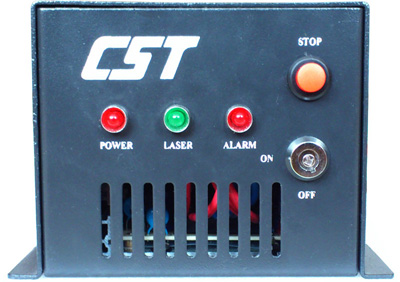 | 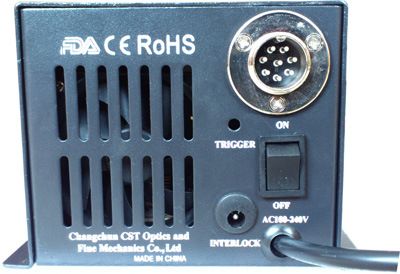 |
On BP are present:
- Interlock connector - contacts must be closed for the laser to work
- Trigger Hole Sticking - TTL Modulation, Active - Low
- Power switch on the back of the unit
- Stop button - emergency shutdown (requirement for hazard class IV)
- Key switch - laser start (hazard class requirements)
- Three indicators: power, radiation and error, respectively
- Laser connector, pinout is as follows:
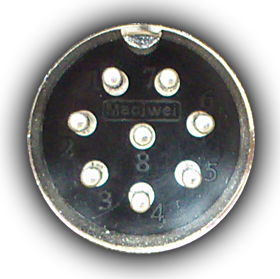
1. TEC +
2. LD +
3. LD-
4. Thermal Sensor
5. Thermal Sensor
6. Fan +
7. TEC-
8. Fan-
Then the Chinese planted a pig : the laser turned on with the lock unlocked and the key turned off, just when you click the button back! This gross violation of TB at the first start-up is very, hmm, surprised. At the same time, I checked the Stop button.
Opening the unit showed that for user convenience, the key and lock connectors are closed with a “nozzle” on the back of the board, and the switch with the key is not connected at all:

Structurally, the unit consists of two modules: a switching power supply for 5 and 12 volts and a combined diode driver with regulator for two thermocouples.
Pulse source

Represents two identical sources in one case: the first - 12V 6.5A, the second - adjustable 4.6–6.3V 6.5A. Do not be confused by the same colors of wires: the top red ones are 5V and the bottom red ones are 12V.
Driver
Not distinguished by its sophisticated design: Three linear current stabilizers on the LM358 op amp and output stages on the IRF530N (MOSFETs on the back of the board) - for the laser diode and two thermocouples. Only one thermocouple is used. The upper left microcircuit is 74LS00, it turns on the laser under the condition of a high level on the TTL modulation connector, the temperature of the sensors matches the expected temperature and the five-second delay timer generated on the NE555 microcircuit (lower left). All other chips are LM358. The leftmost resistor controls the laser current. Large resistors are used as current-measuring shunts. MOSFETs are bolted to a massive heatsink the size of the entire driver board. The laser current stabilizer is powered by + 5V, and thermocouples from + 12V.

The quality of the soldering is average, with traces of manual refinement by a file. Saved on filter elements, otherwise there is no special crime.
The laser current is set to 5.4A, which suggests that the working fluid is pumped by a five-watt IR laser diode. The absence of a second thermocouple means that the KTP crystal does not heat up, and therefore, it may not work in optimal mode, which reduces its service life.
Conclusion
Perhaps the only thing that meets the specifications in this laser is power. But she was given with a margin. The expected service life is also doubtful, but this will become clear when disassembling the emitter. This review, and so it turned out quite voluminous, incl. I will take out the description of the design of the laser itself in the second part.
This laser is very dangerous: not only does it shine with infrared at 700 mW, it also turns on unexpectedly. However, both are simply eliminated. Directly from the Chinese on Aliexpress at the time of writing, such a laser could be bought for $ 650, not including shipping.
Thanks to everyone who read to this place!
